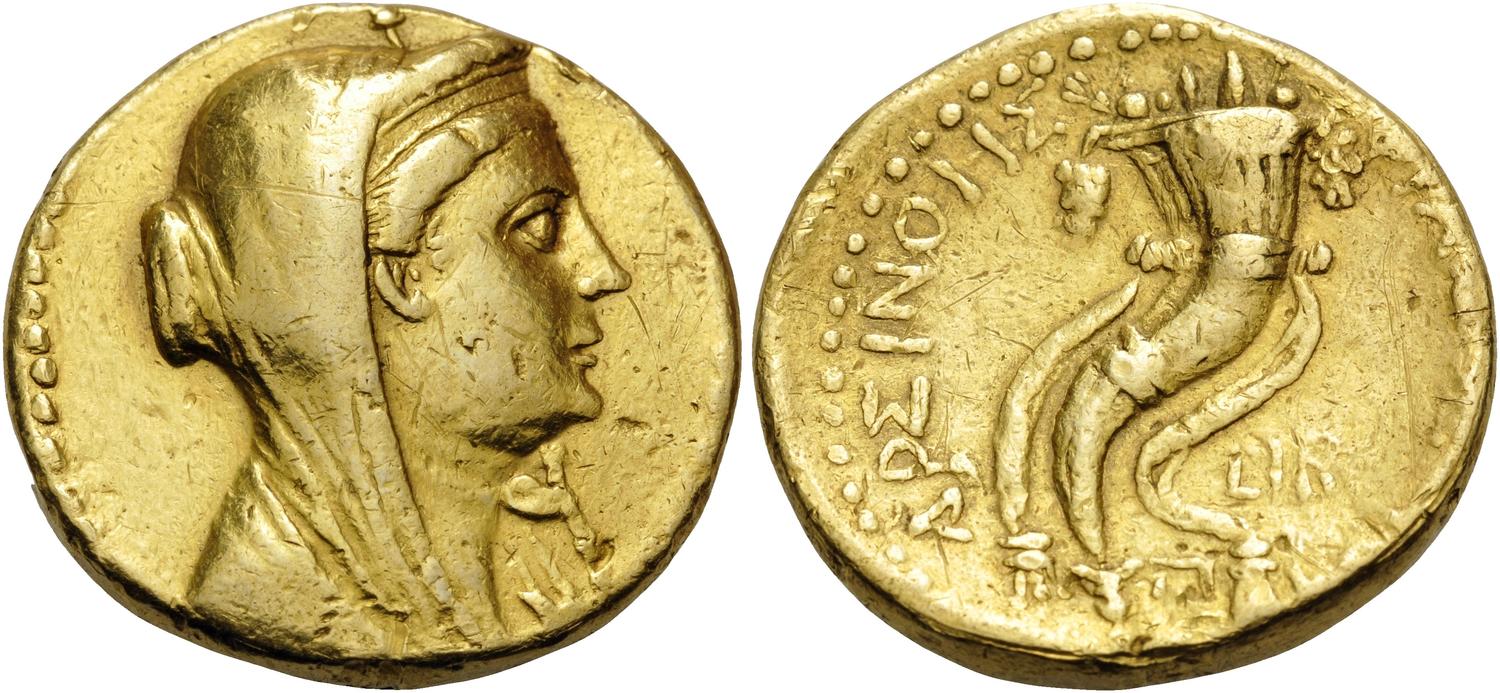Paphos (Ptolemy V), gold, mnaieia (Arsinoe/cornucopiae) (192-185 BCE)
From SILVER
192 BCE - 185 BCE Gold 1,303,507 kg
Description
| ObverseInscription or printing placed on the obverse.: | Veiled head of Arsinoe to right, wearing stephane, with horn of Ammon below her ear and with the tip of a lotos-tipped scepter visible behind the top of her head |
| ReverseInscription or printing placed on the reverse.: | ΑΡΣΙΝΟΗΣ ΦΙΛΑΔΕΛΦΟΥ (Greek).Cornucopiae filled with fruits and bound with fillet, Π below cornucopia, to right, LIB |
Mint and issuing power
| MintIdentifies the place of manufacture or issue of a numismatic object.: | Paphos | Ancient regionAncient region.: | Cyprus | Modern countryModern country: Greece | AuthorityIdentifies the issuing power. The authority can be "pretended" when the name or the portrait of X is on the coin but he/she was not the issuing power. It can also be "uncertain" when there is no mention of X on the coin but he/she was the issuing power according to the historical sources: | Arsinoe II (queen of Thrace, Asia Minor and Macedonia, Ptolemaic queen and co-ruler of Egypt, c. 300-c. 270 BC), Ptolemaic dynasty (323-30 BC), Ptolemy V Epiphanes (Ptolemaic king, 204-181 BC) |
Chronology
| FromIdentifies the initial date in a range assigned in a numismatic context. | 192 BCE | toIdentifies the final date in a range assigned in a numismatic context.. | 185 BCE | PeriodTime period of the numismatic object.: Hellenistic 323-30 BC |
Physical description
| MetalThe physical material (usually metal) from which an object is made.: | Gold |
Median weightMedian of the weights of numismatic objects (in grams). in grams | 27.70 | DenominationTerm indicating the value of a numismatic object. Examples: tetradrachm, chalkous, denarius.: | mnaieion |
StandardStandard.: | Ptolemaic |
Image

S604 Paphos Ptolemy V mnaieia.jpg [1]
References
| Die study referencePublication of the study: | Olivier 20121Olivier 2012, p. 50, n° 22-25 | ||
| Coin series referenceReference to coin series study: | Sear II2Sear II, n° 7854 | ||
Obverse dies distribution
| FrequencyFrequency of specimen in distribution. ᵖ | Number of obversesNumber of obverse dies. ᵖ (o) | % (o) | Number of coinsNumber of coins. (n) | % (n) | Die nameName(s) of the die(s). |
| 1 | 4 | 100 | 4 | 100 | 11, 12, 13, 14 |
| Total | 4 of 4 | 100 | 4 of 4 | 100 |
Reverse dies distribution
no distribution is available
Quantification
| Number of obversesNumber of obverse dies. ᵖ (o) | 4 | Number of singletons (o1)The number of singleton coins. ᵖ | 4 |
| Number of reverse diesNumber of reverse dies. (r) | 4 | Number of coinsNumber of coins. (n) | 4 |
| Coins per obverse dieNumber of coins per obverse die. (n/o) | 1 | Coins per reverse dieNumber of coins per reverse die. (n/r) | 1 |
| Reverse per obverse ratioRatio of obverse dies divided by reverse dies. (r/o) | 1 | Percentage of singletons (o1)number of coins (n) divided by the number of singletons (o1) ᵖ | 100 % |
| Original number of dies (O) (Carter 1983 formula)The estimation of the number of coins according to Carter 1983 ᵖ | 235.29 | Coins struck if 20,000 as average productivity per dieCoins made if the average productivity for obverses (according to Carter) is 20,000. ᵖ | 4,705,800 |
| Original number of dies (O) (Esty 2011 formula)The estimation of the number of coins according to the singleton formula in Esty 2011 ᵖ (O) | Survival rate if 20,000 as average productivity per dieSurvival rate if average productivity is 20,000. ᵖ | 0.00000 | |
| Coverage (o = % of O) (Esty 1984 formula)Esty 1984 - coverage (% of O) ᵖ (o = % of O) | 0% | Die productivity if survival rate 1/2,000Average productivity if survival rate is 1/2,000. ᵖ | 34 |
| Weight of silver (in kg) if 20,000 coins per die (O = Carter formula)Carter 1983 * Median weight * 20000 (*10 if gold or electrum) ᵖ | 1,303,507 kg <br /> 1,303,507 kg | Die productivity if survival rate 1/5,000Average productivity if survival rate is 1/5,000. ᵖ | 85 |
Remarks
References
- ^ Olivier, Julien (2012), Archè et Chrèmata en Egypte au IIe siècle avant J.-C. (204-81 av. J.-C.). Etude de numismatique et d'histoire, [Unpublished doctoral dissertation], Orléans University, 2012.
- ^ Sear, David R. (1979), Greek coins and their values. Vol. II, Asia and North Africa, London, xlviii, p. 317-762